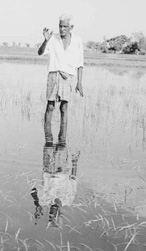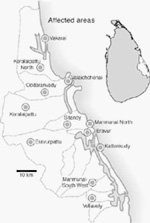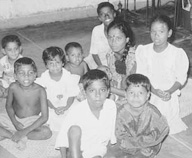The Special Report 2
26th November 2000Washed out
Too little done for big problem, says Batticaloa GA
News/Comment|
Plus| Business| Sports|
Sports Plus| Mirror Magazine

Washed out
Faraza Farook and Nilika de Silva reporting from Batticaloa
 A
recurring flood problem in the Batticaloa district caused extensive damage
this year to homes, paddy lands and the fishing industry as thousands were
left homeless with little attention from authorities.
A
recurring flood problem in the Batticaloa district caused extensive damage
this year to homes, paddy lands and the fishing industry as thousands were
left homeless with little attention from authorities.
As floods ravaged through Batticaloa and other areas of the east which is otherwise caught up in security problems life came to a standstill.
Hundreds of people surrounded us when we arrived at the Sittandy Madhya Maha Vidyalaya in Manmunai North hoping we were there to provide some relief.
The school sheltered more than 400 families and more than 1200 children, most of them under the age of ten.
The relief funds sent to the district were scarcely sufficient to feed the hungry mouths. On certain days it was only breakfast consisting of bread and a supplement or only lunch, while there were days when they received nothing, they lamented.
"Though the Social Services Ministry approved three days' dry rations, that was simply impossible with so many here," the Sittandy Grama Sevaka, S. Weerasingham said.
Although the authorities in Batticaloa struggled to meet the need of the hour, the lack of resources left them helpless.
While the body responsible for disaster management located behind tinted glass windows issued orders from Colombo at grass root level it was impractical.
Life is hard for the people in Batticaloa, with the tense security situation, and the floods make it worse hitting them every year, forcing them to start afresh with their houses and farming lands destroyed.
Batticaloa like Bangladesh turns into a floody hell every twice or thrice a year when the lagoon spills over to the land.
But this year things were worse because the sea level rose too and flowed inwards, while the tanks spilled over and two bunds burst bringing a surge of tank water into the fields and villages.
Almost a week after Batticaloa went under water, claiming three lives, flood victims were seeking refuge in schools and other public places having lost all their belongings .
More than 94,000 families were affected and large numbers were evacuated, as four divisional secretariat divisions were fully cut off from the district capital.
Schools, shops and transport services which were disrupted for two to three days were limping back to normalcy on Wednesday but many people remained in the refugee camps as some areas were still under water.
Most of those affected lamented they were unable to meet the loss. "Our houses are all under water, some of our cattle and household goods such as pots and pans have all been washed away or stolen," Rasaiah Rohini a mother of six said.
"We have to start from scratch . I have to rebuild my house which will cost more than Rs. 10,000," Kumarasami Subramanium said.
Nagalingam Sodhinadhan, Vice Secretary at the Rural Development Society Sittandy, who was among the refugees at the Sittandy school, said the people had hardly any time to save themselves as the flood level rose rapidly.
"It began around 5.30 on Saturday morning and by 7.30 everything was under at least four feet of water," he said.
Despite the torrential rains in which a homeguard was killed, security in the Batticaloa district was strictly enforced.
Logistical problems had to be dealt with, with troops being stationed in the flood affected areas.
Although bunkers were partially underwater, service personnel stuck to their sentry points, and carried out routine procedure.
In the uncleared areas also the floods had inundated vast areas and hundreds of people were evacuated to schools close to Valachchennai and the border zones by the International Committee of Red Cross. Some of the refugees from the uncleared areas were located at the Sungakkeri government school at Valachchenai.
However, by Thursday firewood sellers from uncleared areas were back to sell their wares.
The paddy farmers who form 80 percent of the population in Batticaloa
were the most affected as most of their crops were destroyed. 
The 45,000 hectares of paddy land in the Batticaloa district surrounded by lagoons, tanks and sea, posed a constant threat with heavy rains.
The salinity of the lagoon water is hazardous to paddy and sea water causes devastation. The salinity of the lagoon water is 8.5 ph.
"The only hope we have is that we get enough rains to wash away the salt in the soil, so that we can sow afresh before the season is over," farmer S. Kanaganayagam said.
Showing his 24 acres of paddy land in Thimilativu near Puttur Kanaganayam said he didn't know how he would recover the loss.
"I invested Rs. 75,000 and now everything is under water. We farmers have to wait for the North East Monsoon in August next year to sow again," he said.
Faced with the same disaster every year, the aggrieved farmer said he had to take a loan to begin work again.
Recalling the many farmers from neighbouring villages who had committed suicide unable to pay the debts accumulated due to recurring losses, he feared he too would soon meet the same fate.
In recent years many farmers from Kannankuda, Eeachantheevu, Navakadu, Karayankantheevu in the Eastern Province ended their life unable to repay loans.
The Agricultural Crop Insurance Department stopped providing loans to the farmers two years back believing it to be a futile exercise. Since then only the irrigated paddy lands were insured. Farmers lament that they have no one to turn to for compensation requests.
Agricultural Instructor, Kalladiya Range, Batticaloa District, P. Markandu stressed that immediate measures must be taken to bring relief to the farmers who were isolated in their struggle.
Although the problem has been discussed over the years no action has been taken to safeguard the paddy lands from flood waters.
"Twenty years ago the idea of constructing sluice gates to regulate the sea water flowing into the lagoon was suggested by an NGO but it never materialised," Mr. Markandu said.
Due to security reasons and since people from uncleared areas come to work the paddy fields, the working hours are restricted and the labour cost is high.
On Buffalo Island where there is about 430 hectares of paddy land, the farmers were given a special identity card by the security forces and compelled to register their entry and departure times. The stipulated hours were 8 a.m. to 5p.m.
"We are not allowed to go early or stay back and do more work," lamented S. Chandrasekeran leader of the Farmers Association.
Highland crops including onions, brinjals, snake gourds and pumpkins were also destroyed due to the floods. Assistant Commissioner of Agricultural Services S. Samithamby said more than 4700 acres of highland crop land had been affected.
He said the department had called for a detailed report regarding the loss suffered by paddy farmers in the 17 Divisional Secretariat divisions.
"Everybody wants compensation but that is not possible. However, it is up to the Government Agent to deal with this matter while my responsibility is to assess the actual damage," Mr. Samithamby said.
Fishing, another traditional income generator in Batticaloa was also severely affected following the floods.
The spilling of tank water into the lagoon saw the prawn population being washed away to sea. Fishermen lamented that this season their incomes would drop drastically as prawn sales were their main mode of earning.
They said that due to tank fish having spilled over into the lagoon there was a larger number of fish available close to land, however the expensive varieties such as the prawns had got washed out to sea.
Casting their nets by the light of petroleum lamps, these fishermen spent a large portion of their time throwing back the "useless varieties", which got into the nets in place of the usual prawn. But not giving up they continued to work into the early hours of the morning.
Too little done for big problem, says Batticaloa GA
Caught between the bureaucracy of the centre and the plight of the local population, Batticaloa GA, R. Monagu-rusamy was helpless in the face of the flood disaster. While he was aware of the ground situation and had proposals to minimise the impact of such disasters he was held back by certain constraints. A good drainage system he felt was a long overdue need for the district.Q: How was the farming population in Batticaloa affected by the floods ?
A:The total farming population comprising approximately 550,000 people was badly affected. The floods inundated 40,000 acres of paddy land, just sown, causing massive losses.
We appeal to the Government to give some compensation to the farmers and hut dwellers to rebuild their houses.
Q: What is the estimated loss ?
A:The damage to houses is about Rs. 400 million while the damage to roads, culverts, and tanks is about Rs. 300 million. The loss to paddy fields is about Rs. 100 million.
Q:How soon do you think the affected people will get compensation ?
A:That depends on the process of the government machinery.
Q:Why haven't flood victims in the past been given compensation?
A:Only the most affected people were given compensation last time.
Q:Why have the refugees not been adequately provided for?
A:I have recommended one weeks dry rations. But the Social Services Ministry has approved only three days dry rations and we have not received the allocation yet.
I hope to write to High Commissions to get flood relief from the international community.
Although they can provide assistance in any form, I have listed the requirements according to priority, -16 lakhs of cement blocks, 40,000 bags of cement, 4,000 buckets, 50,000 packets of milk powder and clothing.
Q:Have there been similar losses in previous years?
A:Yes, but this year was the worst after many years. Every year we face annual floods like Bangladesh.
Geographically all the waters from Badulla, Ampara and Polonnaruwa flow into the 100 km long Batticaloa lagoon .
When the lagoon fills it must flow into the sea. This time the rainfall was a little more than last year. There was a depression in the Bay of Bengal and the sea level rose.
Normally the sand builds a bund, this time it has not happened. Heavy rains continued and both sides of the lagoon were inundated.
The Akastian tank and Tharavai tank bunds breached. All irrigation tanks in the district spilled over. And the sluice gates had to be opened to save the tank bunds from being breached.
Rain, rain and more rain A record rainfall in the North Eastern and North Central provinces left thousands displaced and disrupted transport, education and trade. More than 10,000 families in Ampara were displaced and thousands of acres of paddy destroyed. Ampara GA L.S.C. Siriwardena said Alaiyadivembu had been the worst affected in the district. According to reports received from the divisional secretariats 2954 families had been displaced in Alaiyadivembu. Other severely affected areas included Sainthamaruthu, Pottuvil and Akkraipattu. Roads were also impassable in most areas. Polonnaruwa was another district which was badly affected by torrential rains last week. Many tanks including Giritale, Parakrama and Minneriya spilled over disrupting transport and damaging paddy fields. On Sunday the water level had risen inundating the Polonnaruwa- Batticaloa Road. Anuradhapura had also received heavy rainfall.
Floody figures
 Number of families affected in the respective Divisional Secretary Divisions
Number of families affected in the respective Divisional Secretary Divisions
Eravur Pattu 14,245
Manmunai North 10,498
Vellaveli 10,047
Valaichchenai 9775
Kaluwanchikudi 9410
Oddamavadi 8525
Arayampathy 5800
Vavunativu 5761
Kattankudi 5622
Eravur Town 5580
Paddipalai 5071
Vaharai 4200
GA Ampara District LSC Siriwardena said the number of displaced persons following the floods was as follows.
Dehiattakandiya
101
Kalmunai Tamil areas 656
Kalmunai Muslim areas 837
Sainthu Marthu
1481
Karathivu
870
Akkraipattu
1250
Allaiyadivembu
2954
Pothuvil
2000
Erasawa
125
Ampara Town
52
10,326
10,000 acres of paddy field had also gone under water.








![]()
Front Page| News/Comment| Editorial/Opinion| Plus| Business| Sports| Sports Plus| Mirror Magazine
Please send your comments and suggestions on this web site to

